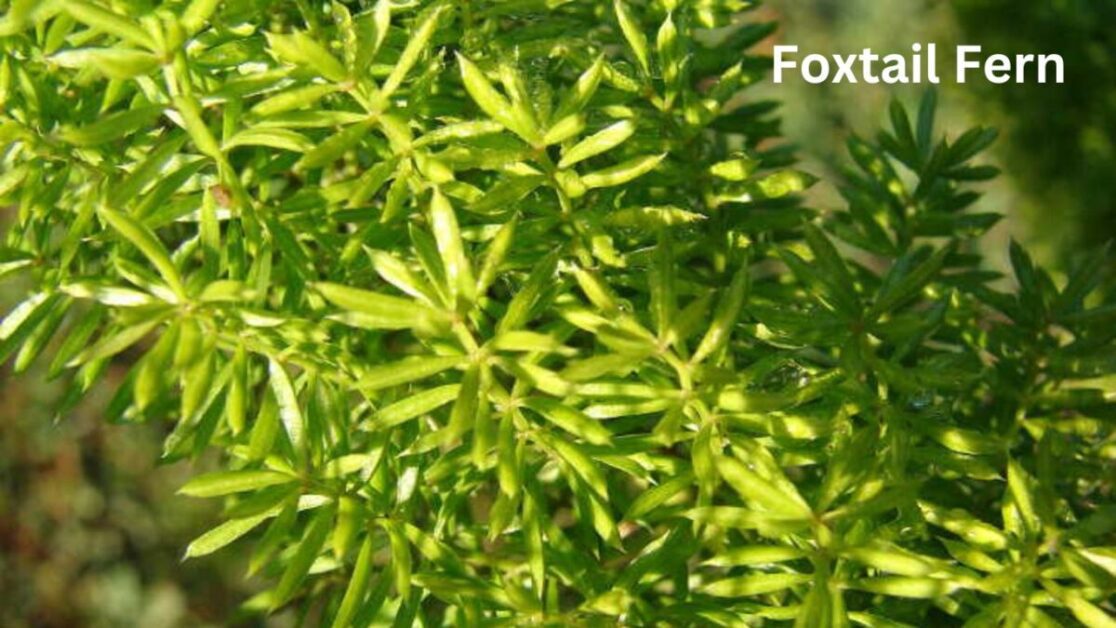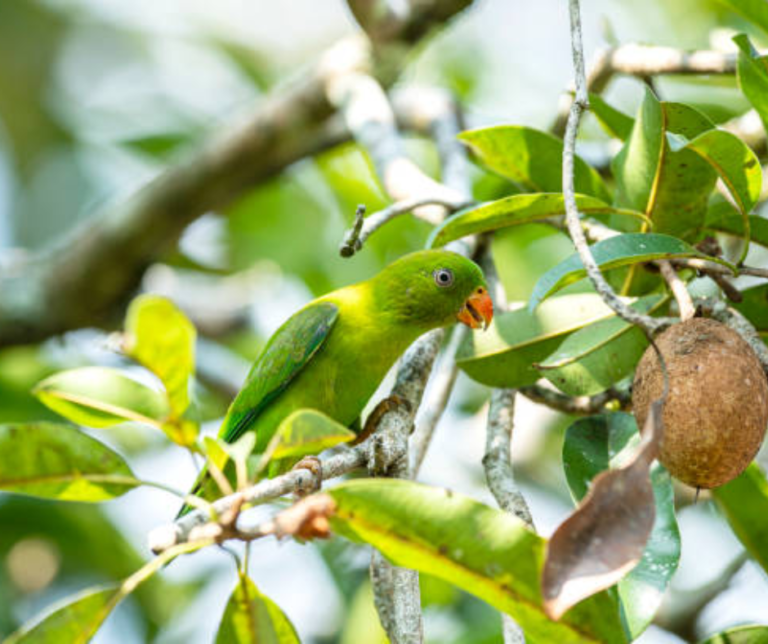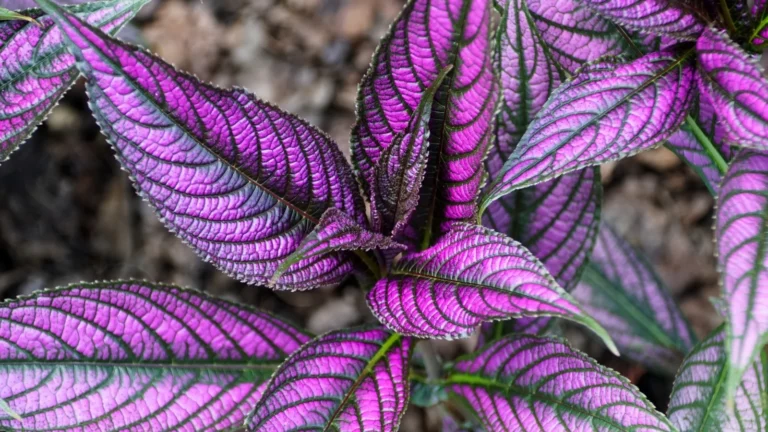Growing Foxtail Fern: The Best and Sly Perennial
Table of Contents
Overview of the Foxtail Fern: An Intriguing Perennial Plant

The foxtail fern, scientifically known as Asparagus densiflorus ‘Meyersii’, is a fascinating perennial plant that can add a unique touch to any garden or landscape. Despite its name, the foxtail fern is not actually a true fern but belongs to the Asparagus family. Native to South Africa, this plant is prized for its feathery, emerald-green foliage that resembles a fox’s tail, hence its name.
One of the most intriguing characteristics of the foxtail fern is its ability to thrive in a variety of conditions, making it a versatile choice for many gardeners. With its dense and compact growth habit, this plant is perfect for both indoor and outdoor settings. Whether you have a small balcony, a sunny patio, or a shady corner in your garden, the foxtail fern can adapt and bring a lush, tropical feel to your space. Its moderate growth rate and low-maintenance nature also make it an excellent choice for beginners or busy gardeners who want to enjoy the beauty of plants without excessive care.
Overview of the Foxtail Fern: An Intriguing Perennial Plant
The Foxtail Fern, known scientifically as Asparagus densiflorus ‘Myers’, is a fascinating perennial plant that captivates gardeners with its unique appearance and hardy nature. Native to South Africa, this plant has gained popularity worldwide for its unusual fronds that resemble fluffy fox tails. The Foxtail Fern is a member of the Asparagus family, but it is not a true fern as its name suggests. It is actually a member of the lily family and belongs to the genus Asparagus.
One of the most intriguing characteristics of the Foxtail Fern is its ability to thrive in a variety of growing conditions. This versatile plant can be grown both indoors and outdoors, making it a popular choice for gardeners with limited space or those who wish to add a touch of greenery to their home. Its adaptability extends to different climates as well, with the Foxtail Fern being hardy in USDA zones 9-11. Whether you live in a warm, tropical climate or a cooler region, this plant can add a unique touch to your garden or living space with its feathery foliage.
Understanding the Unique Characteristics of It
The Foxtail Fern (Asparagus densiflorus ‘Myers’) is a unique perennial plant that offers distinct characteristics that set it apart from other fern varieties. Its feathery and dense foliage resembles the tail of a fox, hence its name. This fern is a native of South Africa and belongs to the family Asparagaceae.
One of the most intriguing features of the Foxtail Fern is its ability to thrive in a wide range of environments. Whether you have a shady corner in your garden or a sunny spot, this versatile plant can adapt and flourish. Its tolerance to various light conditions makes it an excellent choice for both indoor and outdoor settings. Additionally, the Foxtail Fern is known for its drought tolerance, making it an ideal option for regions with limited rainfall. Its ability to thrive in dry conditions allows gardeners to conserve water without compromising on the beauty and aesthetics of their landscape. Furthermore, this fern exhibits a unique resilience to pests and diseases, making it a low-maintenance option for gardening enthusiasts.
Selecting the Ideal Location for Your Foxtail
Foxtail ferns (Asparagus densiflorus ‘Myers’) are a popular choice among gardening enthusiasts due to their unique and intriguing appearance. When selecting the ideal location for your foxtail , there are a few key factors to consider in order to ensure optimal growth and health.
First and foremost, it is important to choose a location that provides the foxtail fern with the right amount of sunlight. These plants thrive in bright, indirect light, making them well-suited for areas with partial shade or filtered sunlight. Placing your foxtail fern in direct sunlight for extended periods can scorch the delicate fronds, while too little light can result in weak growth and pale foliage.
In addition to light, it is crucial to consider the moisture requirements of the foxtail fern. These plants prefer well-drained soil that is consistently moist but not waterlogged. Therefore, it is advisable to select a location that has good drainage, such as a raised bed or an area with sandy soil. Avoid planting foxtail ferns in low-lying areas prone to water accumulation, as excess moisture can lead to root rot and other fungal diseases.
By carefully selecting the ideal location for your foxtail fern and considering factors such as light and moisture, you can provide the optimum growing conditions necessary for these intriguing perennial plants. In the next section, we will explore essential tips for planting foxtail ferns in your garden to further enhance their growth and vitality.
Essential Tips for Planting Foxtail in Your Garden
One of the essential tips for successfully planting foxtail in your garden is to choose the right location. These unique perennial plants thrive in well-draining soil with partial shade or filtered sunlight. It’s important to avoid planting them in areas with direct, intense sunlight, as this can scorch their delicate fronds. Additionally, foxtail ferns prefer slightly acidic soil with a pH level between 6 and 6.5.
When preparing the soil for planting, it’s recommended to incorporate organic matter such as compost or well-rotted manure. This will improve the soil’s fertility and drainage, creating an ideal environment for your foxtail ferns. Before planting, make sure to dig a hole that is slightly larger than the root ball of the plant. Gently place the root ball into the hole, making sure the crown of the plant is level with the ground. Finally, backfill the hole with soil, firming it gently around the roots to eliminate any air pockets.
By following these essential tips, you can ensure a successful and thriving foxtail fern garden in your own backyard. Remember to provide the right location and soil conditions, and take care when planting to give your foxtail ferns the best start for healthy growth.
Watering Strategies to Keep Your Foxtail Thriving
Foxtail ferns are an exquisite addition to any garden with their unique appearance and resilience. However, proper watering techniques are essential to ensure their thriving growth. Foxtail ferns thrive in well-draining soil, so it is crucial to avoid overwatering that can lead to root rot. To determine the ideal watering frequency, it is recommended to check the moisture level of the soil using a soil moisture meter or by inserting your finger into the soil up to the first knuckle. If the soil feels dry, it is time to water your foxtail.
When watering your foxtail , it is important to provide a deep and thorough soak. This allows the water to reach the roots and promotes healthy growth. Water the plants until you see the water coming out from the drainage holes of the container or until the soil is sufficiently saturated in the garden. However, it is crucial to avoid waterlogging the plant as excessive moisture can lead to root diseases. Additionally, during periods of heavy rainfall, it may be necessary to adjust the watering frequency to prevent overwatering. Remember, it is always better to underwater than overwater your foxtail ferns to maintain their health and vitality.
Fertilizing Techniques for Promoting Healthy Growth in Foxtail
Fertilizing plays a crucial role in promoting healthy growth in foxtail ferns. These perennials require a balanced and nutrient-rich diet to thrive and achieve their full potential. When it comes to fertilizing techniques, there are a few key factors to consider.
Firstly, it is important to understand the nutritional requirements of foxtail ferns. These plants typically benefit from a well-rounded fertilizer with equal ratios of nitrogen, phosphorus, and potassium (NPK). Additionally, micronutrients such as iron, magnesium, and manganese are essential for their overall growth and development. It is advisable to choose a slow-release fertilizer specifically formulated for ferns to provide a steady supply of nutrients over time.
Secondly, the timing and frequency of fertilization should be carefully managed. Foxtail ferns should be fertilized during their active growing season, which is typically in spring and summer. It is recommended to apply a balanced fertilizer every 6-8 weeks, following the dosage instructions provided on the product packaging. Over-fertilizing can lead to nutrient burn and damage the plant, so it is important to exercise caution and avoid excessive application.
By adhering to these fertilizing techniques, you can ensure that your foxtail ferns receive the nutrients they need to flourish and exhibit vibrant growth. Remember, proper fertilization is just one aspect of overall care, and a holistic approach is essential for maintaining the long-term health and beauty of these intriguing perennial plants.
Pruning and Maintenance Guidelines for Foxtail
Foxtail ferns, with their unique and captivating appearance, require regular pruning and maintenance to ensure their health and vitality. Pruning plays a crucial role in keeping these ferns in optimal condition and promoting new growth. When it comes to pruning foxtail, it is important to remove any dead or damaged fronds, as well as any overcrowded or crossing stems. This not only enhances the plant’s aesthetic appeal but also reduces the risk of pest infestations and diseases.
To start the pruning process, equip yourself with a pair of sharp, clean pruning shears. Carefully examine the foxtail, identifying any fronds that are discolored, dry, or wilting. Using the pruning shears, make clean cuts at the base of these fronds, ensuring that no stubs are left behind. Additionally, if any stems are growing too close together or crossing over each other, remove the weaker stem to promote better air circulation and prevent rubbing or tangling. Remember, it is crucial to maintain a natural and balanced shape while pruning, as this enhances the overall aesthetic of the fern.
Protecting Foxtail from Common Pests and Diseases

Foxtail , known for their unique and feathery foliage, are generally resilient plants. However, they can still fall victim to common pests and diseases that can hinder their growth and vitality. To protect your foxtail from these potential threats, it is important to be proactive and adopt preventive measures.
One of the common pests that can attack foxtail is the mealybug. These small, white insects are known to infest the leaf joints and undersides of the plant, sucking out the sap and causing wilting. To prevent their infestation, regularly inspect your foxtail for any signs of mealybugs and take immediate action if detected. You can manually remove them by wiping the affected areas with a cotton swab dipped in rubbing alcohol or a mixture of water and dish soap.
In addition to pests, foxtail ferns are susceptible to fungal diseases, such as root rot and leaf spot. These diseases often occur due to overwatering or poor drainage. To protect your foxtail ferns from such conditions, ensure that you provide them with well-draining soil and water them sparingly, allowing the top inch of soil to dry out between watering sessions.
Furthermore, avoid wetting the foliage while watering, as this can promote the growth of fungal spores. If signs of fungal infection appear, promptly remove the affected leaves and treat the plant with a fungicide formulated for ornamental plants, following the manufacturer’s instructions. By taking these preventive measures, you can effectively protect your foxtail ferns from common pests and diseases, ensuring their continued health and vigor.
Propagation Methods: Growing New Foxtail from Existing Plants
Foxtail ferns, commonly known as Asparagus densiflorus, are a popular choice among gardening enthusiasts due to their unique appearance and low maintenance requirements. If you already have a foxtail fern and wish to expand your collection or share it with others, propagation can be an excellent option. There are two main methods for growing new foxtail ferns from existing plants: division and seed propagation.
Division is a straightforward and reliable technique that involves separating the existing foxtail into multiple plants. Start by carefully removing the fern from its container and examining its roots. Look for natural divisions, which are typically visible as separate rhizomes. Using a sharp and sterile tool, such as a knife or garden shears, gently cut the rhizomes apart. Ensure that each division has a portion of both roots and foliage. Once divided, replant each section into individual containers or desired locations in your garden. Be sure to provide them with adequate water and suitable growing conditions to encourage healthy establishment.
Alternatively, foxtail ferns can also be propagated from seeds. Collect the ripe seeds from the plant and place them in a container with moist soil. Cover the container tightly with plastic wrap to create a humid environment. Ensure that the soil remains consistently moist throughout the germination process. After a few weeks, tiny sprouts should start to emerge. Once the seedlings have grown a few inches tall, transplant them into individual pots or suitable garden locations. It’s worth noting that seed propagation can be a longer and less reliable method compared to division, as it may take several years for the plants to reach maturity and resemble the parent plant.
Choosing the Right Containers for Growing Foxtail Indoors
When it comes to growing foxtail ferns indoors, choosing the right containers is crucial for the health and well-being of these intriguing plants. Opting for the appropriate containers not only provides sufficient space for the ferns to grow, but also ensures proper drainage and adequate ventilation.
First and foremost, it is recommended to select containers that are at least 12 inches in diameter, as foxtail have an impressive root system that requires ample room to spread out. Additionally, choosing containers with drainage holes in the bottom aids in preventing waterlogged soil, which can lead to root rot. By allowing excess water to escape, these holes help maintain the optimal moisture levels that foxtail ferns thrive in.
Providing Adequate Light and Temperature Conditions for Indoor Foxtail
Indoor foxtail ferns require specific light and temperature conditions to thrive. These plants prefer bright, indirect light, making them perfect for a spot near a north or east-facing window. Avoid placing them in direct sunlight, as it can scorch their delicate fronds. If you don’t have access to ample natural light, you can supplement it with artificial grow lights. Position the lights about eight to twelve inches above the plant to mimic the intensity of natural sunlight.
In addition to light, temperature plays a crucial role in the health of indoor foxtail ferns. These plants thrive in temperatures between 60°F and 75°F (15°C to 24°C). Avoid placing them near drafts, air conditioning units, or heaters, as extreme temperature fluctuations can stress the plant. Maintaining a consistent temperature will help foster healthy growth and prevent any potential damage. It’s also essential to keep in mind that foxtail ferns appreciate moderate humidity levels. Consider using a humidifier or placing the plant on a tray filled with water and pebbles to create a humid microclimate around it. Following these light and temperature guidelines will ensure your indoor foxtail ferns flourish.
Seasonal Care for Foxtail Ferns: Winterizing and Preparing for Spring
Foxtail ferns, known for their delicate and feathery fronds, require careful attention during winter to ensure their longevity and proper growth in the upcoming spring season. As the temperatures drop, it is crucial to take certain steps to protect these beautiful plants from the harsh winter conditions. One essential aspect of winter care for foxtail ferns is providing adequate insulation.
Insulation can be achieved by adding a layer of mulch around the base of the plants. This mulch acts as a protective barrier, shielding the roots from extreme cold temperatures. Additionally, you can cover the ferns with a frost cloth or burlap to provide extra protection against frost and freezing winds. It is important to secure the covering properly, ensuring that it does not touch the fronds directly. These simple measures will go a long way in safeguarding your foxtail ferns during winter and setting them up for a vibrant and healthy growth in the following spring.
Creative Uses for Foxtail Ferns in Landscape Design

Foxtail ferns, with their unique and captivating appearance, offer a multitude of creative possibilities for landscape design. Their elegant upright fronds, resembling fluffy fox tails, add a touch of drama and texture to any outdoor setting. One of the most popular creative uses for foxtail ferns is incorporating them into container gardens. Placed in decorative pots or hanging baskets, these ferns instantly elevate the visual appeal of patios, balconies, and entryways.
If you’re looking to create a focal point in your garden, consider using foxtail ferns as standalone specimens. Planted in strategic locations, such as near a garden bed or along a pathway, these ferns can serve as eye-catching features that draw attention and create interest. Their bright green foliage contrasts beautifully with other plants, making them ideal candidates for creating visual impact.
Another creative idea is to use foxtail ferns to soften the edges of hardscapes, such as stone walls or paved areas. By positioning these ferns along the edges, you can add a natural and soft touch to an otherwise rigid and structured space. The feathery fronds gently cascade over the edges, providing a sense of grace and movement.
In summary, foxtail ferns provide a wealth of creative opportunities in landscape design. Whether incorporated into container gardens, used as focal points, or employed to soften the edges of hardscapes, these versatile plants add a touch of elegance and interest to any outdoor space. So go ahead, experiment with different placements and combinations, and let your imagination run wild with the endless possibilities of foxtail ferns in your landscape.
Companion Planting Ideas to Enhance the Beauty of Foxtail Ferns
Enhancing the beauty of your foxtail ferns through companion planting can create a visually stunning and harmonious garden. By carefully selecting compatible plants that complement the unique characteristics of the foxtail fern, you can create a captivating and well-balanced landscape design.
One excellent companion plant to consider is the impatiens. With their vibrant and colorful flowers, impatiens provide a striking contrast to the delicate fronds of the foxtail fern. Placing these two plants together can add a pop of color and visual interest to your garden bed or container. Additionally, impatiens thrive in partial shade, making them an ideal choice for underplanting the foxtail fern, which also enjoys dappled sunlight.
Another fantastic companion for the foxtail fern is the lobelia. With their graceful trailing habit and vivid blue or purple blooms, lobelias can create a stunning cascading effect when paired with the upright growth of the foxtail fern. This combination adds depth and texture to your garden, elevating its overall aesthetic appeal. Lobelias also prefer moist conditions, which align well with the watering requirements of the foxtail fern.
By carefully selecting companion plants that harmonize with the unique characteristics of the foxtail fern such as impatiens and lobelias, you can enhance the beauty of your garden and create a visually captivating landscape. The right combination of plants can create a balanced and harmonious display that showcases the elegance and charm of the foxtail fern. In the sections that follow, we will explore more companion planting ideas to further inspire and guide you in creating a remarkable garden featuring the foxtail fern.
Here’s a table outlining some key considerations for growing Foxtail Ferns:
| Aspect | Description |
|---|---|
| Scientific Name | Asparagus densiflorus ‘Myers’ (Foxtail Fern) |
| Light | Bright, indirect light is ideal. Avoid direct sunlight, especially in hotter climates. |
| Temperature | Prefers temperatures between 60-70°F (15-21°C). Can tolerate some fluctuations. |
| Watering | Keep soil consistently moist but not waterlogged. Allow the top inch of soil to dry out slightly between waterings. Avoid overwatering. |
| Soil | Well-draining potting mix with organic matter. A mix of peat moss, perlite, and sand is suitable. |
| Fertilizer | Feed monthly during the growing season with a balanced liquid fertilizer diluted to half strength. Avoid over-fertilizing. |
| Humidity | Prefers moderate to high humidity levels. Mist foliage regularly or use a humidity tray to increase moisture levels. |
| Pruning | Trim yellow or brown fronds regularly to maintain a tidy appearance. Divide and repot overcrowded plants every few years. |
| Propagation | Easily propagated by division. Divide the plant at the roots and replant sections in fresh soil. Can also be grown from seeds. |
| Pests | Generally pest-resistant but may occasionally attract spider mites or mealybugs. Monitor regularly and treat promptly if detected. |
| Disease | Generally disease-resistant but susceptible to root rot if overwatered. Ensure proper drainage and avoid waterlogged conditions. |
| Containers | Suitable for containers, hanging baskets, or as a ground cover in suitable climates. Ensure containers have drainage holes. |
| Winter Care | Reduce watering frequency during the winter months but ensure the soil doesn’t dry out completely. Protect from cold drafts. |
| Special Features | Drought-tolerant once established. Deer-resistant. Can be grown indoors as a houseplant or outdoors in mild climates as ground cover or in mixed borders. |
This table provides a comprehensive overview of the key factors to consider when growing Foxtail Ferns, helping to ensure their successful cultivation and maintenance.
Frequently Encountered Challenges in Growing Foxtail Ferns and How to Overcome
Frequently Encountered Challenges in Growing Foxtail Ferns and How to Overcome
Foxtail ferns are generally known for their resilience and adaptability, making them relatively easy to care for. However, like any plant, they can face challenges that may hinder their growth and overall health. One common issue that gardeners encounter is root rot, which can be caused by overwatering or poorly draining soil. To prevent this, it is crucial to ensure that the soil drains well and that the fern is not sitting in water for extended periods. Additionally, it is important to resist the temptation to overwater, as these plants prefer slightly drier conditions. Regularly checking the moisture level of the soil and allowing it to slightly dry out between waterings will go a long way in preventing root rot.
Another challenge faced by gardeners is pesky pests such as mealybugs and scale insects. These tiny creatures can quickly spread and wreak havoc on your foxtail fern. To combat this issue, regularly inspect your plant for any signs of infestation, such as sticky residue or white cotton-like masses. In the event of an infestation, gently remove the pests with a soft, damp cloth or cotton swab, taking care not to damage the foliage. For severe cases, using an insecticidal soap or neem oil can effectively control these pests without harming the fern. It is essential to repeat the treatment as necessary to completely eradicate the infestation and prevent reoccurrences.
How often should I water my foxtail fern?
Foxtail ferns prefer to be kept consistently moist, but not overly saturated. Watering once a week should be sufficient, but adjust based on the moisture levels of the soil.
Can I grow foxtail ferns indoors?
Yes, foxtail ferns can be grown indoors as long as they receive adequate light and temperature conditions. Place them near a window that receives bright, indirect sunlight.
What kind of fertilizer should I use for foxtail ferns?
Use a balanced, water-soluble fertilizer with equal amounts of nitrogen, phosphorus, and potassium. Apply it during the growing season, following the instructions on the label.
How do I protect my foxtail ferns from pests and diseases?
Regularly inspect your foxtail ferns for pests such as mealybugs or scale insects. Treat any infestations with an appropriate insecticidal soap or horticultural oil. To prevent diseases, ensure good air circulation and avoid overwatering.
Can I divide my foxtail fern to propagate new plants?
Yes, foxtail ferns can be divided to propagate new plants. Carefully dig up the plant and separate the rhizomes, making sure each division has healthy roots. Replant the divisions in separate pots or garden areas.
What kind of containers are suitable for growing foxtail ferns indoors?
Choose containers with drainage holes to prevent waterlogged soil. Terracotta or ceramic pots are ideal as they provide good drainage and stability for the plant.
How do I winterize my foxtail ferns?
In colder regions, bring your foxtail ferns indoors before the first frost. Place them in a cool, well-lit area and reduce watering frequency. Trim back any damaged or dead fronds to promote healthy growth in spring.
Can foxtail ferns be used as companion plants in a garden?
Yes, foxtail ferns can be paired with other plants such as begonias or impatiens to enhance their beauty and create a visually appealing garden display.
Are foxtail ferns deer-resistant?
Foxtail ferns are generally considered deer-resistant due to their texture and odor, which is unappealing to deer. However, it’s important to note that individual deer preferences may vary.
Can I grow foxtail ferns in full sun?
Foxtail ferns prefer partial shade or filtered sunlight. While they can tolerate some direct sunlight, too much exposure to full sun may cause the fronds to burn or wilt.







